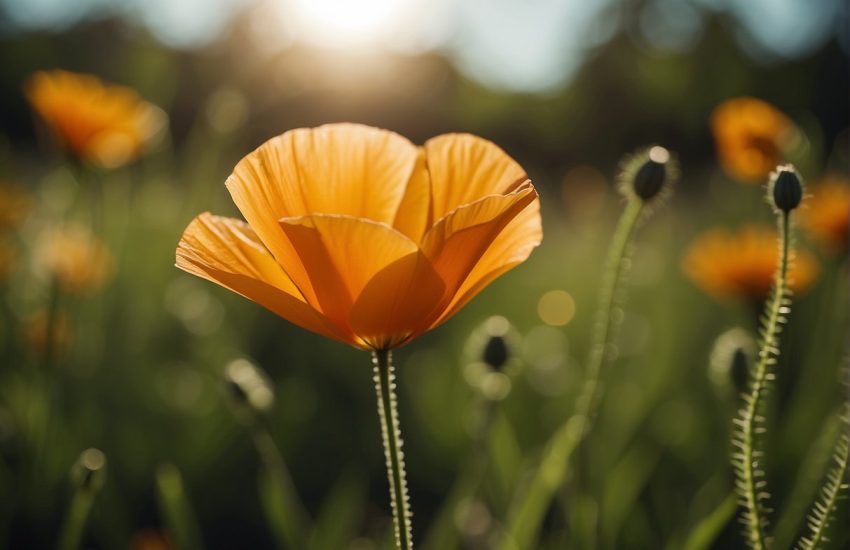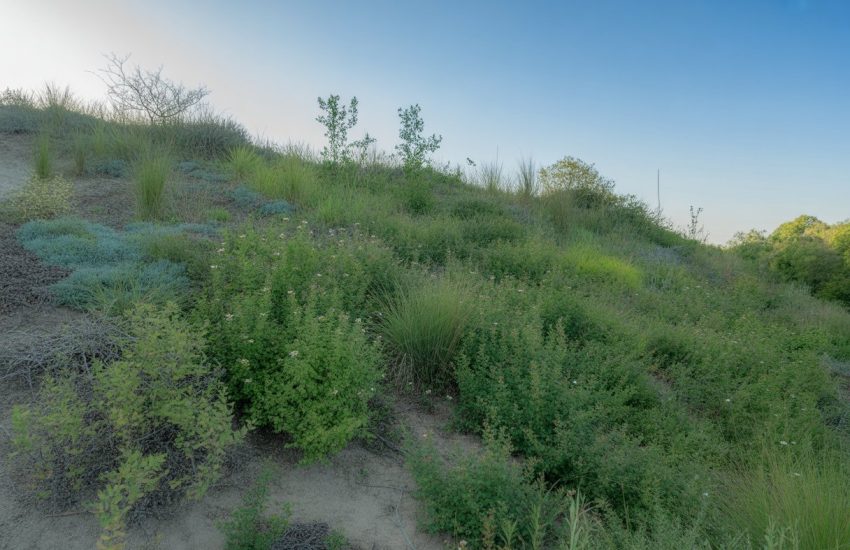Plants Native to Maryland for Landscaping [with Pictures]
A plant can be considered native if it naturally occurred in a particular ecosystem or region without human intervention. These plants easily adapt more to the soil, weather, and moisture than exotic plants. Native plants need less care, less water, and fertilizers. They don’t require pesticides to keep them alive. These plants can escape from the universe. Native plants support wildlife by providing food and shelter for wild animals such as insects and birds.
In Maryland, these native plants have covered most of the surface land and can even be found on the ocean shores. Maryland is characterized by native plants of different categories, including trees, shrubs, and perennials. This state can be referred to as a naturalist dream and a gardener’s paradise due to the wide classification of native plants.
This article explains many native plants in this ecoregion. Keep reading to know more about the various plant species found in Maryland.
Maryland’s Native Trees
Trees are among the critical aspects that keep the universe running. They provide oxygen, improve air quality, regulate temperature, especially when the conditions are hot and dry, and provide shade. Trees are also a beauty to our gardens and yards. Maryland has a huge classification of trees. The following represents native trees in this state.
1. Blackgum (Nyssa sylvatica)

This is a huge tree representing the dogwood tree family. Blackgum grows up to 90 feet tall and is found in most forests in Maryland. This tree is widely known for its beautiful color, alligator-hide bark, and pollinator-attracting flowers. Blackgum is popular with wildlife; its fruits are consumed by woodpeckers, squirrels, bears, foxes, wild turkeys, and songbirds. This tree can be planted in the garden under specific conditions, including average to wet moisture, pH 6.5 or less soil, and full sunlight penetration.
2. White Oak (Quercus alba)
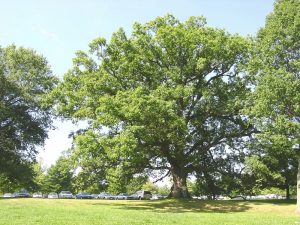
One can find White Oak in Maryland’s dry woodlands to moist areas. Its height ranges between 60 and 100 feet, and it blossoms mostly between March and May, in full sunlight. White Oak prefers acidic soil with a pH of less than 6.5, with moisture medium to dry. This tree requires soil that is neither compact nor fertilized with artificial fertilizers.
Small White Oak’s roots can be destroyed by wild animals or other activities because it grows in loose soil. It has many beneficiaries, including songbirds, bobwhites, woodpeckers, chipmunks, deer, squirrels, and even people. It hosts many insects, including butterflies and walking sticks. White Oak is Maryland’s official tree. It is beautiful and majestic; it can provide shade for a significant period if planted.
3. Eastern Redbud (Cercis Canadensis)
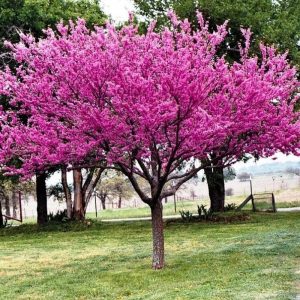
It is a deciduous tree found in Maryland Coastal plains, Mountain, and Piedmont. Its typical height is from 20′ to 35′ and has lavender to light pink flowers which blossom from April to May. Eastern Redbud prefers full sunlight to partial shade and dry to occasionally moist soil. It is exploitable to leaf anthracnose, Verticillium Wilt, and Botryosphaeria canker.
This tree is a good specimen for woodlands, pollinator gardens, or yards. Its growth duration is over 30 years. Some butterflies and bees usually feed on its nectar. Several species of moths, such as the White-Marked Tussock Moth and the lo-Moth, live in Eastern redbud. The songbirds and Northern Cardinals; can eat its seeds. Planting this tree can provide a beautiful garden and wildlife support.
4. American Hornbeam (Carpinus caroliniana)
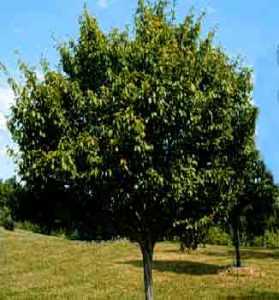
This is a Maryland state all seasons tree that grows to 30 feet tall and 9 meters wide. It grows in full sunlight and shade; the American hornbeam needs well-drained, moist, and fertile soil. It can tolerate full shade, but the fall coloring is best in full sun. American hornbeam also tolerates periodic flooding and various soil conditions, including wet sites, dry sites, clay soil, and alkaline soil. It perfectly grows in woodland or naturalized gardens and shady landscapes.
American hornbeam does not require routine maintenance. However, diseased, congested, cross shoots, and damaged trees compromise its survival. However, pests and diseases do not affect it regularly, but its leaves can get twig blight and cankers. American hornbeam is native to Maryland and other US states.
5. Paper Birch (Betula papyrifera)
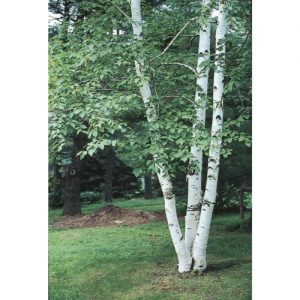
Paper Birch is a Maryland native tree characterized by an attractive white bark that peels off in strips to show an orange-brown bark underneath it. A mature Paper Birch usually develops black spots on the white back. Its dark green leaves habitually turn pale yellow and wither. This tree develops tiny yellowish-brown male flowers and greenish female flowers during spring.
Paper Birch was named so due to its papery bark. People used it as writing material long ago because they would peel it to get a writing surface. It grows up to 70 feet tall and 50 feet wide. Paper Birch grows in full sun and well-drained soil, medium to wet. It can grow in a wide range of soils, including rocky or sandy soils, which are consistently moist. Paper Birch can be affected by aphids, rust, leaf spot, and sawflies.
6. Flowering Dogwood (Cornus florida)
This tree is propagated in Maryland’s woods-edge habitat and woodland understudy. Its height can be from 20 to 30 feet tall. Flowering dogwood’s flowers are petal-like bracts; they emerge while green and develop to become white. These flowers primarily manifest in April, but sometimes they emerge in May. Insects such as bees, flies, beetles, and butterflies feed on nectar from Flowering Dogwood’s flowers.
Flowering Dogwood is widely known as a small tree. It commonly features in area gardens and is of interest every season. It has prominent flowers that combine well with other wild plants in spring. In autumn, its leaves fall significantly to prepare for the winter season. Mature Flowering Dogwood trees usually have a broad canopy due to horizontal branching. This tree blooms in full and has fewer leaf infections. This tree can decline in persistently dry soils or when droughts recur. It is sensitive to pollution and cannot be found on the roadsides.
7. Green hawthorn (Crataegus Viridis)

Green hawthorn is distributed in Maryland’s Coastal plains. It grows to a maximum of 35 feet tall; in specific conditions, which are clay or loam soils of pH 6.0 to 7.3, and full to partial shade. Its natural habitation is lowland areas, swamps, and valleys with full and partial shade and medium to wet soil. However, there is a cultivated variety of Green hawthorn, which is tolerant to full sunlight and can adapt to a variety of soil conditions and also air pollution, thus a good choice for urban regions.
Green hawthorn has different characteristics in various seasons. Spring usually has white flowers; in autumn, scarlet-red foliage and small fruits can persist until winter. These fruits are considered edible but not proven for human consumption. Mature Green hawthorns habitually shed the outer grey patches to reveal the orange back underneath.
Maryland’s Shrubs
There are many types of shrubs in Maryland with unique characteristics and benefits. Below is a discussion of the most common among them.
Hillside Blueberry (Vaccinium pallidum)
It is a low-bush shrub variety of the genus Vaccinium. Hillside blueberry grows naturally in Maryland’s sandy areas or dry woods. This shrub can thrive in various landscapes, soil, and light conditions; therefore, one can use it in pollinator gardens.
Hillside blueberry can reach around 1.5 to 2 feet tall in a full sun environment. It can tolerate various soil textures and its blossoms between April and May. They can form colonies that carpet the forest floor. Wild animals such as box turtles, back bears, and orioles consume Hillside blueberry’s fruit. They are host plants for several species of butterflies and chalcid wasps. Hummingbird moths and bumblebees do their pollination.
Northern Bayberry (Morella pensylvanica)
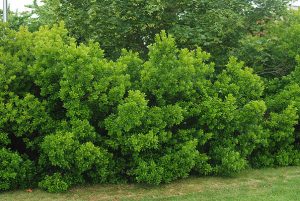
This is a Maryland native plant found in tidal areas, marshes, swamps, coastal plains, and dunes. It can be evergreen or deciduous depending on the parent’s plant genetics and the impact of extreme conditions during winter. Northern bayberry produces small waxy gray berries on the female plant; a male plant only pollinates. Its berries are used to manufacture bayberry candles.
This plant is critical in slope soil erosion control. It can tolerate informal edges, wet and salty grounds, and drought. Its berries are fed on by various birds, which include Catbirds, American Robins, Bluebirds, Thrashers, Cedar Waxwings, Mockingbirds, and Yellow-ramped Warbler. It is also used as food by several species of moths. Hence it can be an excellent choice for a butterfly garden.
Red Chokeberry (Aronia arbutifolia)

This shrub blossoms from March to May with attractive white flowers, which fall to give room for producing orange-red berries. Red chokeberry is found in most parts of Maryland and is considered part of the rose family. It can reach 13 feet tall and thrives in full sun and partial shade. Red chokeberry grows in every soil texture and prefers dry or moist conditions. However, it is tolerable to wet conditions.
This shrub grows in acidic soil with a pH below 6.8. It is an ideal garden choice because it can grow on the edges. It is good for a bird garden, stream or pond edges, and slope erosion control. It usually produces new shoots at its base (suckers). Therefore it can be pruned yearly but still, look healthy.
Inkberry Holly (Llex glabra)
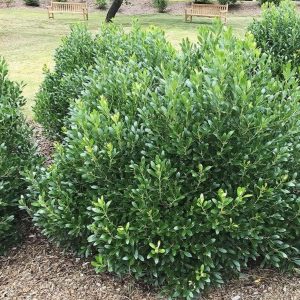
It is an evergreen shrub native to the coastal plain of Maryland. Inkberry holly grows naturally at swamp edges, sandy dunes, and sandy woodlands. This plant tolerates droughts, salt exposure, and flooding and can adapt to all soil textures. It matures slowly and spreads gradually through rhizomes (root suckers).
Its male and female are separate plants. Its female plants that grow on fertile soils establish small black berries. The female species of Inkberry holly include Compacta, Shamrock, and Nigra. The male plant is not classified. This shrub can be used in a pollinator garden, privacy screen, foundation plant, and wherever a new plant flavor is needed.
Winterberry Holly (Ilex verticillata)
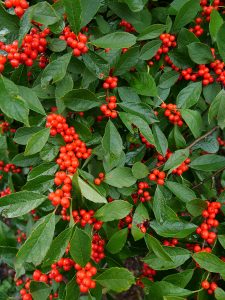
It is a deciduous shrub located in forested wetlands and swamps in Maryland. Winterberry Holly is often used for rain gardens, hedges, borders, bird gardens, and foundations. It is characterized by attractive berries and food for birds such as Cedar Waxwing, American Robin, Gray Catbird, and Eastern Bluebird. It hosts several moths and butterflies. Winterberry Holly prefers sunny conditions and various soil textures, given its high organic matter and moistness. It thrives in acidic soil with a pH ranging between 4.5 and 6.5. Winterberry holly is native to the coastal areas but can also be found in Maryland’s Mountain and Piedmont regions.
Leucothoe axillaris (Coastal dog hobble) or Highland dog hobble (Leucothoe fontanesiana)
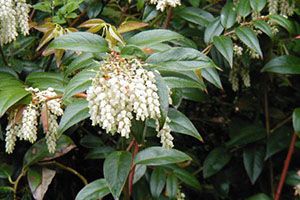
It is a 2-4′ and 3-6′ wide shrub, native to Maryland’s moist woods, thickets, and swamp in the coastal zone. It contains a quarter-inch-long white flower that establishes three inches long racemes or pendulous clusters after spring. Its flowers are fragrant, and its leaves turn from bronze to purple in winter. Leucothoe primarily survives in acidic, well-drained, and moist soils. Its flowers provide nectar and pollen for butterflies and bees, thus suitable for wildlife gardens.
Perennial Plants that are Native to Maryland.
The term perennial refers to a plant lasting up to 2 years. This time is widely used to differentiate plants with little or no wood from shrubs and trees, which are hypothetically perennials. In Maryland, these perennials can be further classified into grasses and sedges, wildflowers, and groundcovers and ferns. The discussion below is about various perennial plants in those three classifications.
Perennial Groundcovers and Ferns
Groundcovers and ferns are perennials with green foliage and can thrive in shady areas. They are the perfect choice for covering large open lands and filling gaps between shrubs and trees. They are discussed below.
Christmas Fern (Polystichum acrostichoides)
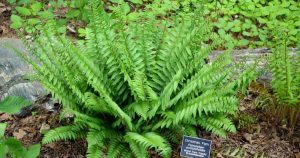
It is a hardy evergreen fern found across Maryland. This fern thrives in shady areas and can fit in garden woodlands and under trees. Christmas fern got its name because of its perseverance to bad weather conditions throughout the holiday period. It is leathery, robust, and has green and glossy fronds. This plant thrives in cool, well-drained, and moist soil under a shade. Christmas fern requires a full-time wet ground.
Golden Groundsel (Packera aurea)
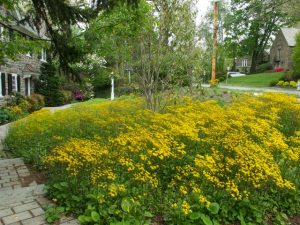
Golden groundsel is a type of wildflower located in most parts of Maryland. It has bright yellow flowers blooming in summer; a golden fuzz covers its leaves. Groundsel is native and fast-growing; its leaves are heart-shaped and green with purple undersides. Its central stalk is primarily naked. Therefore it is vertical. Groundsel grows in dry to medium moisture, full sun to partial shade, and well-drained soils. It can be an excellent choice for a meadow perennial or a ground cover.
Foamflower (Tiarella cordifolia)
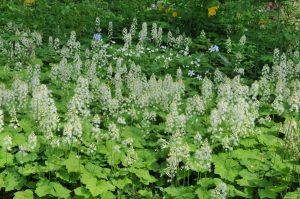
This type of wildflower is widely found in Maryland. It has delicate and white fragrant flowers that blossom in the spring; their leaves resemble bubbles or foam. Foamflowers are hardy perennials; therefore, they can tolerate various types and conditions of the soil. However, they thrive in moist and well-drained soil. They are excellent for shady landscapes such as home gardens and under trees. Foamflowers can also be used as an accent plant or ground cover.
Green and Gold (Chrysogonum virginianum)
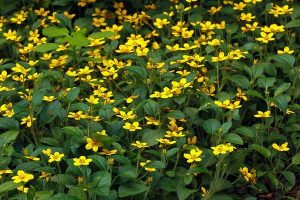
Green and gold are perennials that grow close to the ground. They have dark green leaves, triangularly shaped, whose length is 2 inches. Its flowers are star-shaped and bright yellow, blossoming at the start of autumn. Its flowers have five rounded and slightly serrated petals, which are 1.5 inches wide. Green and gold tolerate various conditions, although it thrives in moist and well-drained soil. It is an excellent choice for shade areas like woodland gardens and under trees.
Sensitive Fern (Onoclea sensibilis)
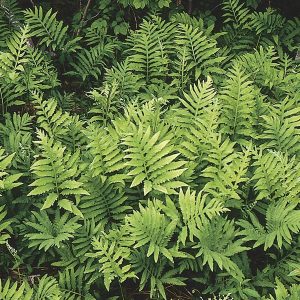
It has large, lobed, and light chartreuse-colored leaves. The sensitive fern grows best in wet clay soil in a shady environment. It can grow in garden soil, provided it is wet and has enough moisture. The sensitive fern grows fast through rhizomes; given an ideal condition, it can reach 3 feet tall. Its leave curl up and turns brown when exposed to harsh conditions. Sensitive fern leaves often die during winter but return when it’s spring. It is a good choice for gardeners seeking to grow ferns in wet areas or those who want to cover their clay soil sections. This fern can be used as an accent plant or a ground cover.
Lady Fern (Athyrium filix-Femina)
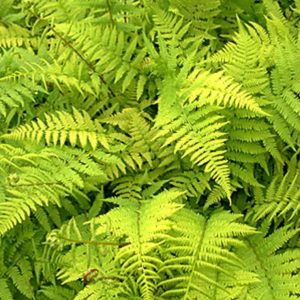
They are hardy, evergreen perennials in various parts of Maryland. Lady fern grows best in shady areas. Thus they are the ideal choice to be grown in woodland gardens or under trees. It has delicate, light-green fronds and can grow to 5 feet tall. However, when it’s well-cultivated, it can reach 7 feet tall. Lady ferns thrive in complete shade and fertile, moist, well-drained soil. It has shallow roots, and therefore, it’s not suitable for growing in walkways and areas with wild animals such as squirrels and antelopes.
Wild Ginger (Zingiber capitatum)
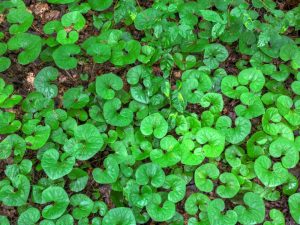
It is a perennial plant 10 inches tall and between 12 and 24 inches wide. Wild ginger is non-invasive and contains evergreen and heart-shaped leaves. This perennial grows moderately slowly and can adapt to various seasons and locations. Its flowers blossom between April and May and are located at the plant’s base, on the leaves’ undersides. The plant produces a ginger-like scent when its leaves are detached. Growing wild ginger in large groupings or as a ground cover is ideal for a woodland garden or a sunny border.
Pussytoes (Antennaria plantaginifolia)
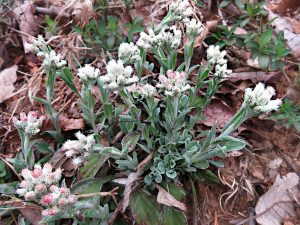
They are a member of the Aster family and can be found in most states of the USA’s eastern half, including Maryland. It has other names such as Plantain-leaved Pussytoes and Woman’s Tobacco. This perennial plant is typically grown due to its velvety leaves and pale pink flowers.
Its name emanated from its flowers which look like the cat’s toes. Pussytoes can grow up to one foot, but their leaves grow on the ground. They are spread by rhizomes and can provide a ground cover for dry areas such as rock surfaces. Pussytoes are poisonous in some parts, so they are vulnerable to animals such as rabbits and deer.
Perennial Grasses and Sedges Found in Maryland
Maryland has many native grass and sedges within its territories. These plants have various colors and textures; therefore, they are ideal for establishing an organic characteristic in any garden. These plants also provide habitat to wildlife. They are discussed below.
Wool Grass or Wool Rush (Scirpus cyperinus)
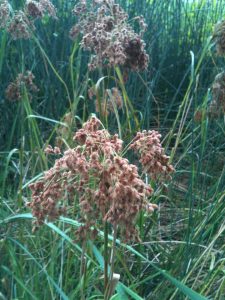
Its name emerges from its cinnamon-brown wooly mass of seeds. Wool grass can grow best in full sunlight, moist to wet soil, and form a clump of about 3 feet in diameter. This grass provides textural movement and contrast in the garden, mostly located in Maryland. Wool grass foliage can tolerate harsh conditions during winter. It is a host to many insects, including the Eyed Brown and the Skipper, meaning it is an excellent choice for a butterfly garden.
Blue Sedge (Carex flacca)

This perennial plant is widely known for its soft blue foliage. Blue sedge can form a clump of narrow, arching leaves that are blue-green at the top and glaucous-blue at the bottom. This plant blooms with brown flower terminal spikes when summer begins. Blue sedge is a perfect choice for gardens since it can easily spread and form a dense ground cover.
Blue sedge can grow faster to a height of 12 inches and a width of 18 inches. This plant spreads over time by suckers (rhizomes), forming a cover. It thrives best in full sunlight and medium to wet soils. However, it can be drought tolerant if it is well established. Blue edge’s soft blue foliage can color up any garden.
Little Bluestem (Schizachyrium scoparium)
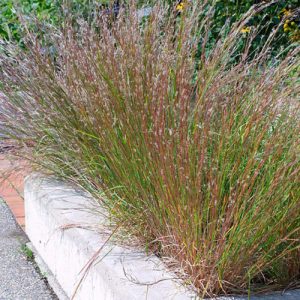
It is Maryland’s native plant with brilliant blue-green color and an upright form. Little Bluestem is highly decorative, and its foliage maintains its color all year. It is a food source for animals such as quails, rabbits, songbirds, and deer. Many birds often use it as a nesting cover. Its nectar attracts butterflies, bees, and sparrows; goldfinches feed on its seeds.
Yellow Indian Grass (Sorghastrum nutans)
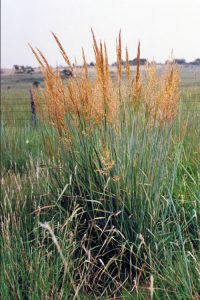
It is a tall, golden-brown grass with broad dark green leaves and narrow blue-green blades. Yellow Indian grass has an orange to purple color. This grass can be fed by livestock. It is tolerable to drought, flooding, and recurring burning, which occurs to most grass types. Yellow Indian grass thrives in sunny weather and dry to medium soil.
Maryland Perennial Wildflowers
These are the native plants that add beauty and color to the landscapes of Maryland. Flowers are essential in providing food for various pollinators, including birds, butterflies, and bees. Most perennial wildflowers are usually appropriate for landscaping.
Here are the most common perennial wildflowers found in Maryland.
Blanket Flower (Gaillardia pinnatifida)
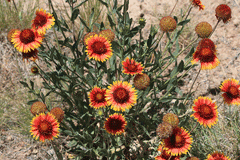
It is also called the red dome blanket flower. The blanket flower is a perennial sunflower native to most parts of Maryland. It has wavy to lobed and hairy leaves, about 3 inches; it has densely packed brown-purple disk flowers and yellow ray flowers. Its disk flowers are bisexual, while the ray flowers are sterile. Blanket flower is a drought-tolerant plant whose blooming period is from May to August.
Butterfly Weed (Asclepias tuberosa)
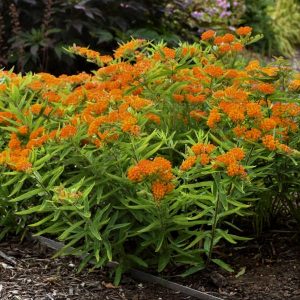
It is a beautiful wildflower whose height is 3 feet. Its bloom period ranges from June to September, and it grows best in well-drained soils. This perennial wildflower can be attacked by aphids and, therefore, may require maintenance if planted in the garden.
Cardinal Flower (Lobelia cardinalis)
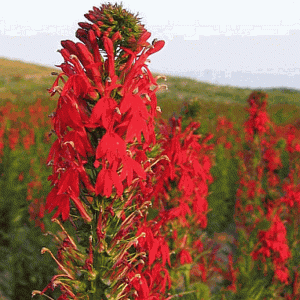
It is found in wet wood areas of Maryland. The Cardinal flower can grow up to 4 feet tall and blossoms intensely in its velvety red flowers from June to September. They prefer partial or full shade but can survive in the sun if the soil is wet. Cardinal flowers can be an excellent addition to a pollinator garden, hummingbird garden, shade garden, and damp locations.
Foxglove Beardtongue (Penstemon digitalis)
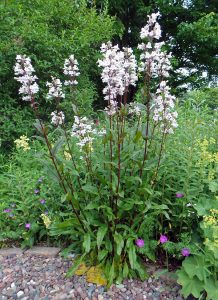
It is a stunning wildflower that blooms at the beginning of summer. The Maryland native plant can grow to a height of 3 feet and produces pink flowers. Foxglove beardtongue thrives in moist and well-drained soil.
Eastern Columbine (Aquilegia canadensis)
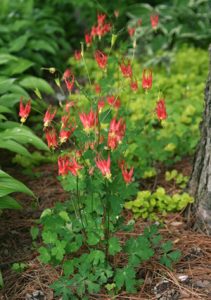
It is a popular flower in Maryland, which blossoms in the spring. This wildflower reaches a height of about 2 to 3 feet, producing yellow and red flowers. Eastern columbine is a perfect choice for hummingbird gardens, rock gardens, and butterflies gardens because it can thrive in dry conditions.

